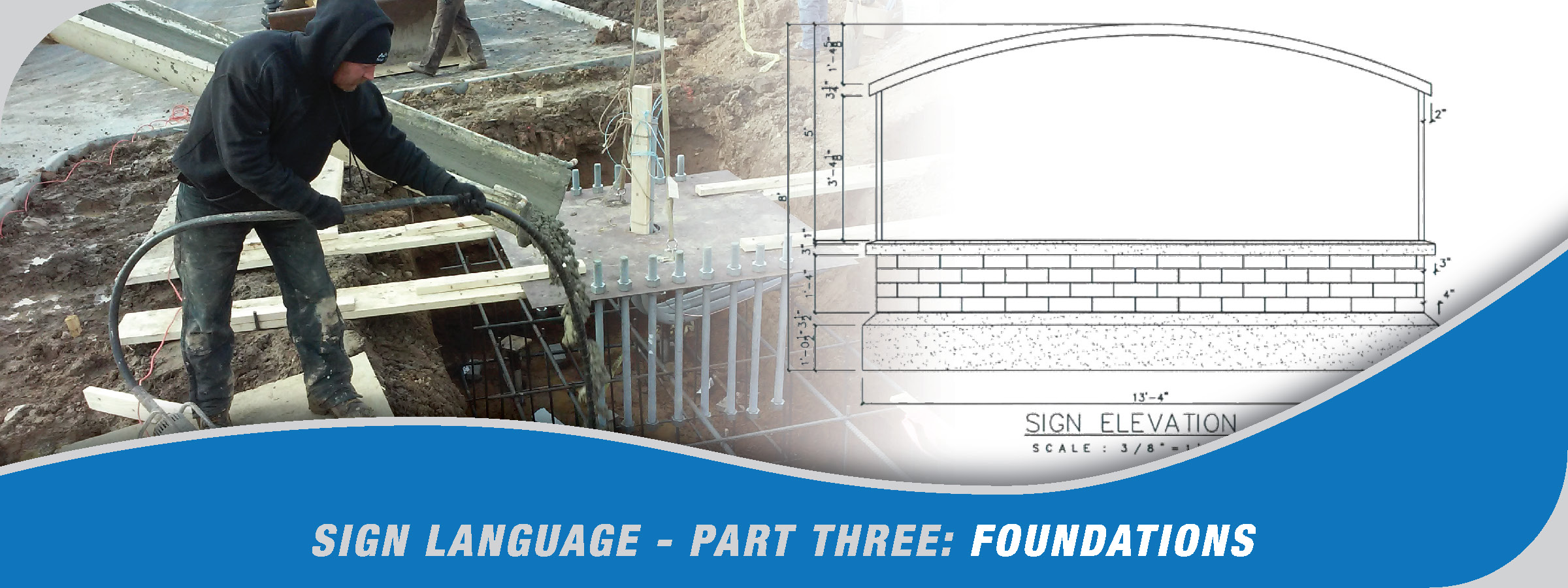
Permanent free-standing exterior signage requires a foundation of some kind. To determine what type of foundation any sign needs will require engineered drawings and must meet zoning regulations. Here are some terms associated with sign foundations to keep in mind:
· Excavation
· Spoils
· Footer/concrete
· Rebar/Rebar cage
· Conduit
· Forms
· Pole
· Anchor Bolt
· Plate mount
· Direct Bury
· Block
· Utility check
· Drawings/Certified
Excavation is about digging the foundation hole. The size and height of the sign and the type of soil and climate where the business is located will determine the size and depth of the hole. It may require an auger to dig or if it is also quite wide, it may require other equipment such as a backhoe. The spoils are the excess soil that is removed, and the excavator should include hauling that away as part of their services.
The foundation itself is usually made of concrete. If a hole is left open between the excavation and foundation stage, rainwater could potentially fill in the hole and would have to be drained before concrete could be poured. Otherwise, the foundation would be diluted and not strong enough for supporting the sign.
Before pouring concrete, all structural elements will need to be set into the hole including any rebar or rebar cage, pole, anchor bolts and possibly conduit. Rebar is installed into the foundation as a steel reinforcing rod or mesh of steel wires used to strengthen and hold the concrete in compression. Any signage that uses a pole to attach the sign cabinets will usually either use a direct bury method or a plate-mount method. The direct bury requires setting the pole into the hole and pouring concrete around it. This may be used in conjunction with rebar. Ensuring the pole is level is important to the overall sign installation. A pole that is going to use a plate will have anchor bolts set into the concrete. This requires the use of a form, laid out ahead of time to line up the plate holes with exactly where the bolts must be later attached. This form will help hold the bolts in place while concrete is being poured. Another crucial element is the electrical conduit for buried wiring to bring power to the sign. This must also be set in the concrete.
For plate mounted poles, special fabrication is required for the plates used. These are made specifically for the requirements of the pole or poles used and the pole’s plate welded onto it. Hand holes are also cut into larger poles for access to wiring.
A sign using masonry will almost always require a block base sitting about 2 feet below grade on top of the foundation. In this case, the concrete is only poured to that level before the base begins. Many people are drawn to the idea of a free-standing sign with a masonry base. However; material costs and the large foundation for such signs can make it a very expensive investment.
There are other options that do not include a weighty foundation and can still create an appealing structural design. The use of a faux base that resembles brick or stone can save on foundation costs as well as using a pole skirt. The foundation for these options is always smaller than using real masonry.
A utility check on the property is required before excavation to ensure safety. The excavator should call the appropriate Utility services to mark the location of their lines.
Engineered drawings are required for all new structures especially ones where electric is involved but also to ensure the structure meets engineering requirements. Stamped engineered drawings will be required for permitting new signage on a property in most cases.
Knowing the process of installing a sign foundation helps everyone understand the overall labor and expense involved. Knowing the terminology can enhance your ability to express concerns and pose questions throughout production.
Hopefully, your foundation of sign terminology is meeting the requirements for helping you to plan your own strategies for success. Please dig into our previous blog posts regarding ‘sign language’ to help increase your knowledge base. And feel free to contact us with your plans and questions.
